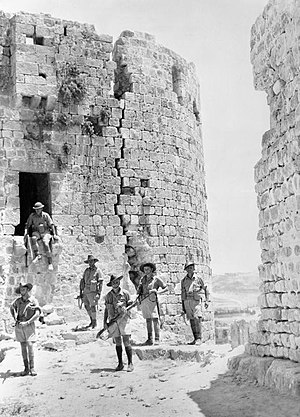Syria–Lebanon campaign
British offensive in World War II, 1941 / From Wikipedia, the free encyclopedia
Dear Wikiwand AI, let's keep it short by simply answering these key questions:
Can you list the top facts and stats about Syria–Lebanon campaign?
Summarize this article for a 10 years old
The Syria–Lebanon campaign, also known as Operation Exporter, was the invasion of Syria and Lebanon (then controlled by Vichy France) in June and July 1941 by British Empire forces, during the Second World War.
| Syria–Lebanon campaign | |||||||||
|---|---|---|---|---|---|---|---|---|---|
| Part of the Mediterranean and Middle East theatre of the Second World War | |||||||||
 Australian troops among the ruins of the Sidon Sea Castle, Lebanon, July 1941 | |||||||||
| |||||||||
| Belligerents | |||||||||
|
|
| ||||||||
| Commanders and leaders | |||||||||
|
|
| ||||||||
| Strength | |||||||||
|
~34,000 troops
1 landing ship 5 cruisers 8 destroyers |
Vichy France: ~35,000 troops
289 aircraft 2 destroyers 3 submarines German Luftwaffe: At least 10 bomber aircraft[1] | ||||||||
| Casualties and losses | |||||||||
|
c. 4,652 Australian: 1,552 Free French: c. 1,300 British and Indian: 1,800, 1,200 POW, 3,150 sick 41 aircraft[2] |
Vichy France: 6,352 (Vichy figures) 8,912 (British figures) 179 aircraft 1 submarine sunk 5,668 defectors Germany: 4 aircraft[1] | ||||||||
Free French campaigns | |
|---|---|
|
Military actions of Vichy France during World War II | |
|---|---|
1940
1941
1942 1944
1945
|
On 1 April 1941, the Iraqi coup d'état had occurred and Iraq had come under the control of Iraqi nationalists led by Rashid Ali, who appealed for Italian and German support. The Anglo-Iraqi War (2–31 May 1941) led to the overthrow of the Ali regime and the installation of a pro-British government. During this conflict, key Vichy figure Admiral François Darlan had allowed German aircraft to use Vichy airfields in Syria for attacks against the British in Iraq.[3] The British invaded Syria and Lebanon in June, to prevent the Axis powers from using the Vichy French-controlled Syrian Republic and French Lebanon as bases for attacks on Egypt, during an invasion scare in the aftermath of the Axis victories in the Battle of Greece (6–30 April 1941) and the Battle of Crete (20 May – 1 June). In the Western Desert Campaign (1940–1943) in North Africa, the British were preparing Operation Battleaxe to relieve the siege of Tobruk and were fighting the East African Campaign (10 June 1940 – 27 November 1941) in Ethiopia and Eritrea.
The French conducted a vigorous defence of Syria but, on 10 July, as the 21st Australian Brigade was on the verge of entering Beirut, the French sought an armistice. At one minute past midnight on 12 July, a ceasefire came into effect and ended the campaign.[4] The Armistice of Saint Jean d'Acre (Convention of Acre) was signed on 14 July at the Sidney Smith Barracks on the outskirts of the city. While the surrender was being held, Time magazine referred to the Syria-Lebanon campaign as a "mixed show", and the campaign to this day remains relatively unknown, even in the countries that participated in it.